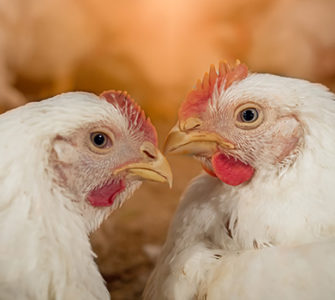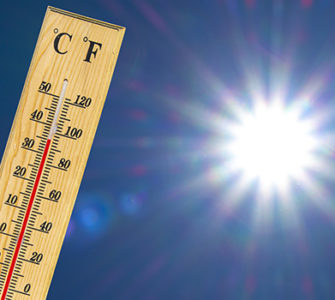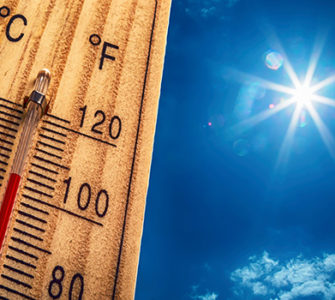Check equipment now to help birds withstand summer heat
By Jess Campbell, Jeremiah Davis and Kelly Griggs, National Poultry Technology Center, Auburn University
A common question we’re often asked as the summer approaches is “where do we start with getting our houses ready for hot weather to ensure our birds remain as healthy and productive as possible?”
A finely tuned house is a good place to start. It can be difficult to manage a hot weather flock when equipment is malfunctioning, so getting houses and equipment working properly allows producers to spend more time growing chickens and less time solving problems.
In general, the more attention a grower gives to fine-tune the house to keep the birds comfortable before the heat arrives, the better the flock will perform.
With this in mind, following these five best management practices will help keep grower housing and equipment on track — regardless of the age of the house.
1. Check generator, electrical and alarm service
A continuous supply of power and a reliable backup electrical system are vital.
Producers are responsible for making certain that all automatic transfer switches, generators, electrical panels, wires, breakers and alarm batteries are working properly. This requires routine servicing and testing of all equipment.
Do not get caught off-guard this summer with a backup power glitch that causes the loss of a house or entire farm of birds. If you have not fully loaded your generator or tested the backup power systems for your operation, now is the time to do so.
Money and time spent on preventative maintenance on the backup power system, including all components, is a very good investment. It only takes one weak link to cause a chain to break. Stocking up on spare fuses, fuel, filters and breakers is a good idea in case of an emergency.
Yearly servicing and weekly testing are also important, as it would be detrimental to have losses as a result of a power failure.
When it comes to fuel filters, these should be replaced annually. Also check to see if there is water in the fuel (catching filter contents in a pan will help indicate if water is present). Spare fuel filters should be kept on hand in the generator shed.
We recommend replacing alarm batteries yearly, or even sooner if necessary. Writing the date on all alarm batteries will act as a reminder for when they should be replaced.
2. Tighten houses
Holes in the ceiling drawing in attic air during the day can be a major source of unwanted hot air.
Air leaks during hot weather can be much warmer than the outside ambient temperature thanks to the sun radiating on the metal house. Depending on the source of the leak, some air leaks can be as much as 40° F warmer.
The goal is to get the house as tight as possible, with a minimum of about 0.10 inch to 0.13 inch static pressure, using the rule of thumb of 1 cubic foot per minute (cfm) of fan power per square foot of floor space.
As an example, a 20,000-square-foot house running one good 48-inch fan (about 20,000 cfm with cone and clean shutters) should be able to achieve 0.13 inch static pressure.
If the house only pulls 0.08 inch static pressure in general, then work should be done to increase the tightness for the benefit of the grower. A tightness test should be conducted with the help of a trained company representative that understands how to conduct the test properly.
Pre-flock house testing is important to ensure maximum wind speed and evaporative cooling.
Attic leaks
If you have attic inlets, a common issue to look for during testing is damaged inlet doors.
We found two damaged attic-inlet doors in houses last summer. The picture on the left was in a house with smaller birds during brooding. This is not a serious problem during the day, but it represents a huge heat-loss problem at night.
The picture on the right was taken in a house in full-tunnel and evaporative-cooling mode. These 110° F (or more) air leaks from the attic work against tunnel speed and cooling.
The amount varies, but these damaged inlets are allowing several thousand cfm (each) of hot air into the house. Ceiling air leaks like this must not be tolerated in hot weather.
3. Fan maintenance
Fan maintenance is required to achieve maximum full-tunnel ventilation performance and efficiency. Pre-flock inspection and testing of fans should be a high priority.
We have seen houses increase full-tunnel wind speed by 50 feet per minute (fpm) by simply cleaning the fan shutters. Dirty shutters and wire screens, worn or dry bearings, worn belts and weak tensioners are fan-efficiency robbers.
For example, a house with properly cleaned fans may need only six fans, while a house with dirty fans may have to run eight fans to achieve the same heat removal and target temperature.
Running additional fans will increase electrical cost for heat removal during hot weather. To put it another way, we would rather use fewer like-new fans instead of more worn-out fans to get the job of heat removal and wind speed done.
These before and after photos show how dirty shutters can lower fan efficiency and tunnel windspeed. We added over 50 fpm of wind speed in this house simply by cleaning the 12 tunnel-fan shutters with our hands.
Keep a close eye out for dirty shutters during hot weather, and clean them before they start reducing fan performance and bird cooling. This is important for all flocks but especially true for large-bird flocks.
4. Clean pads
We get many calls and emails about how to clean pads and when to replace them. In short, take some pads out of the system and inspect them carefully.
If the pads are structurally sound and salvageable, then give them a good cleaning by blowing the flutes out and follow with an approved cleaner and water.
The better job you do at cleaning flutes, the longer pads will last. Some growers blow their pads out after each summer flock. It is always a good idea to record static pressure at full tunnel.
For example, if the full-tunnel pressure was 0.08 inch new and it is 0.12 inch today, there’s a good chance the pads may be clogged and need to be thoroughly cleaned or replaced.
If you really want to know how bad your existing pads are, compare them to new ones. You might be surprised by what you discover.
If cleaning has not been done in years, it will be a difficult (impossible, in some cases) job to return them to their original state. Thorough cleaning of the pads and the entire recirculation system annually (at minimum) is important, even on newer farms.
5. Tunnel inlet or door maintenance
This is often a forgotten task that can cause significant issues in a flock when a problem arises.
We see a lot of broken ropes, rusted chains, pulleys and sprockets, and it’s important to make sure curtains and doors are in tip-top shape and good working order.
Take the time today to thoroughly inspect all moving parts, including hinges, to make sure tunnel inlets are opening and closing properly.
If you notice a sudden increase in pressure at full tunnel that was not there the day before, there is a good chance you have a restriction at the inlet that could have potentially been prevented.
Pre-flock inspection, repair and adjustments are easier to make prior to flock placement, especially in hot weather.
Create a best-practice routine
The most effective management practices are those that are documented so the grower can ensure all necessary equipment is inspected and tuned-up on a routine basis.
Take the time to make schedules, take notes and log dates when the equipment was serviced. This will help prevent things like generators overheating or running out of fuel, a fan belt from breaking or a feed line motor from going out prematurely.
It only takes one glitch to cause major problems for growers in hot weather. Usually it isn’t the things that we know were done that cause problems — it’s often the things we forget to maintain, and those often cost the most money to correct.
Keeping things simple, getting equipment service reports documented and making lists are all key to ensuring houses are prepared for warmer months and that birds are able to remain healthy and perform at their best.
Posted on August 12, 2020





















